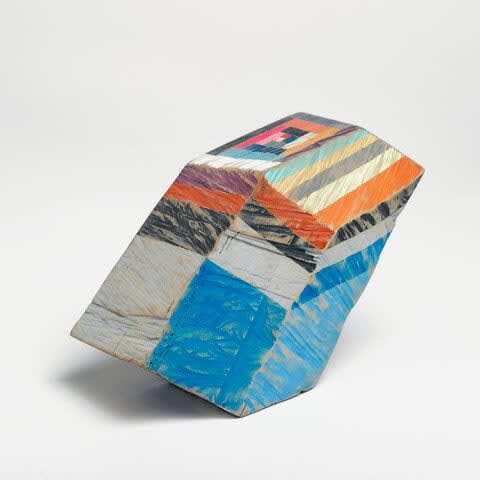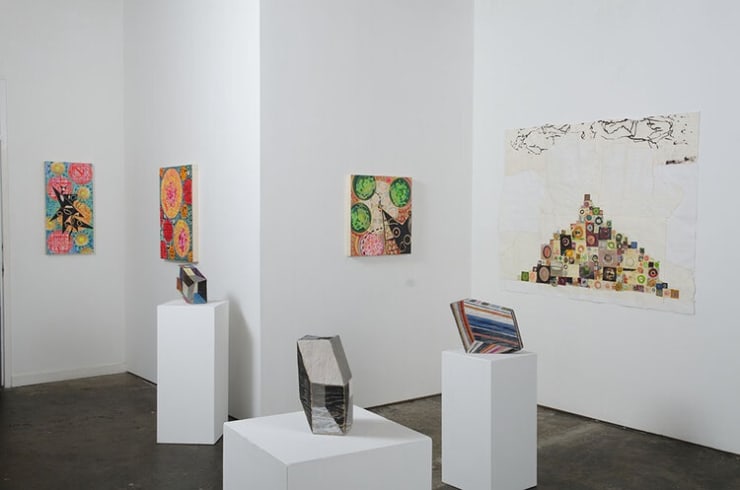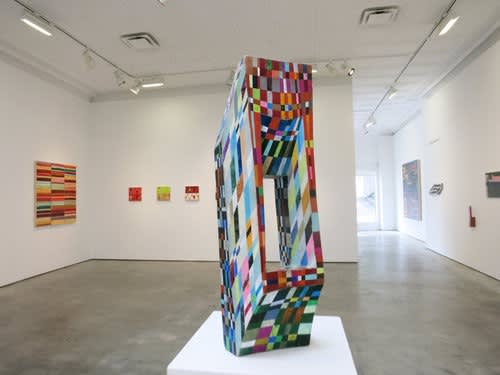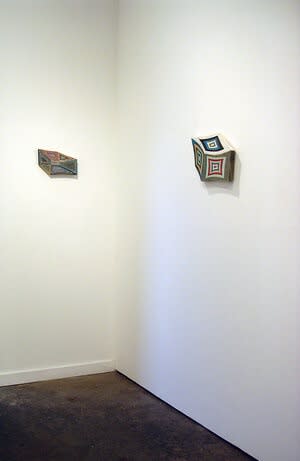Clark Derbes
-
 Clark DerbesBandscape, 2020carved, polychromed sugar maple12 x 15 x 5 inchesView More Details
Clark DerbesBandscape, 2020carved, polychromed sugar maple12 x 15 x 5 inchesView More Details -
 Clark DerbesQuilting Bee, 2020carved, polychromed sugar maple8 x 10 x 6 1/2 inchesView More Details
Clark DerbesQuilting Bee, 2020carved, polychromed sugar maple8 x 10 x 6 1/2 inchesView More Details -
 Clark DerbesSpinning Bookcase, 2020carved, polychromed sugar maple14 1/2 x 10 x 8 inchesView More Details
Clark DerbesSpinning Bookcase, 2020carved, polychromed sugar maple14 1/2 x 10 x 8 inchesView More Details -
 Clark DerbesTime Travel Agency, 2016carved, polychromed sugar maple16 1/2 x 11 x 8 inchesView More Details
Clark DerbesTime Travel Agency, 2016carved, polychromed sugar maple16 1/2 x 11 x 8 inchesView More Details
Derbes describes his work as "sculptures of paintings of sculptures". Known for both art forms, Derbes's optically-illusionistic carved and painted wood sculptures confuse the eye and play with our perception of space and reality. The artist has called these humble blocks of wood, seemingly awkwardly carved, covered with dizzying geometries that contradict immediate interpretations, "simultaneously primitive and futuristic”. Derbes uses a chain saw to cut wood blocks from a variety of woods, such as elm, poplar and maple into a form called a "hypercube" a twelve-sided rectangular solid he stumbled upon in his quest for a form on which to paint. Continuing to sculpt the wood block to it's final shape, Derbes then paints it with gouache, sands it down and rubs it with notepaper, leaving it with a satiny surface. His palette ranges from vibrantly rich jewel tones to subdued neutrals. Derbes uses geometry, pattern, shape, and scale shifts to obtain a degree of trompe l‘oeil that is both familiar and surprising.
Clark Derbes was born in New Orleans, Louisiana in 1978 and raised in Baton Rouge. He earned a BFA at Louisiana State University in 2002. He exhibits nationally in galleries and institutions. Derbes currently lives and works in Vermont with his wife, artist Wylie Sofia Garcia and their two children.
Ever mindful of his roots, Derbes remains closely tied to the community of Baton Rouge, executing numerous public artworks over two decades. Prolific and opportunistic, he is deeply engaged with the people, youth, and public spaces in these cities. Along with dozens of commissioned murals, Derbes “self-commissioned” work has appeared on scores of trailers in an 18-wheeler truck yard, intersection utility boxes, asphalt surfaces of an abandoned stretch of interstate in Burlington, VT, and highway support columns in blighted Baton Rouge neighborhoods. These works in accessible, ‘non-art’ spaces are indistinguishable from his other public art - underscoring his ingenuity and persistence. The aesthetic relationship between Derbes’s murals and his studio work is strong and direct, shifting from chainsaw-carved wood to two story concrete buildings with ease.
-

3 Sided Square
Clark Derbes, Mery Lynn McCorkle, George Long 7 Aug - 26 Sep 2020Read more -

august geometry
Frances Barth, Jeff Conefry, Clark Derbes, Scott Eakin, Kevin Finklea, Tim Flowers, Richard Harris, Duncan Johnson, Mary Judge, Joanne Mattera, Justin Rabideau 7 Aug - 5 Sep 2015Read more -

The Doors of Perception: Recent Sculptures
Clark Derbes 23 Oct - 14 Nov 2014Read more -

abstract part 2
Clark Derbes, Amanda Hughen, Lorri Ott, Deborah Zlotsky 28 Dec 2013 - 28 Jan 2014Read more








